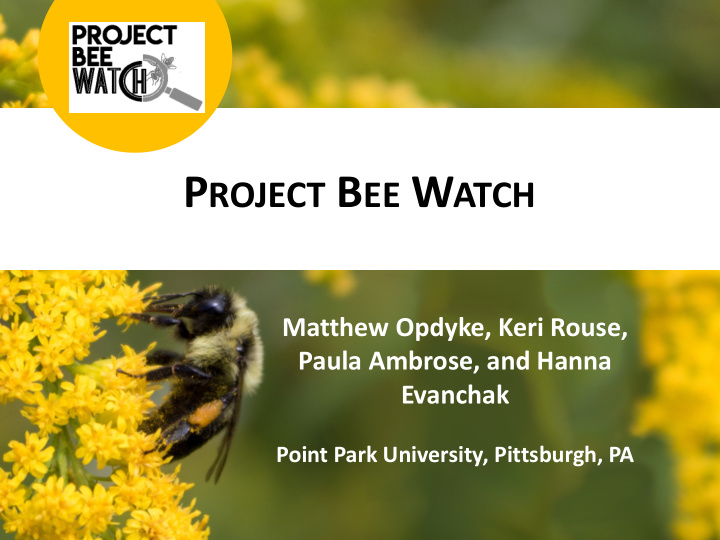



P ROJECT B EE W ATCH Matthew Opdyke, Keri Rouse, Paula Ambrose, and Hanna Evanchak Point Park University, Pittsburgh, PA
P ROJECT O BJECTIVES Establish a citizen science project in southwestern Pennsylvania to 1. Develop baseline data of insect pollinators 2. Identify pollinator preference for forage plants 3. Educate and recruit citizen scientists to serve as ambassadors in the conservation of pollinators Latodami Nature Center
S TATUS OF B EE P OLLINATORS IN N ORTH A MERICA • More than half of native bees are declining in North America, with 1-in-4 at risk of extinction (Center for Biological Diversity 2017) • Decrease of overall bee abundance across 23% of U.S. land area between 2008 and 2013, with dramatic declines in bumble bee species (Cameron et al. 2011, Koh et al. 2016) Cameron et al. 2011. Patterns of widespread decline in North American bumble bees. Proc Natl Acad Sci 108:662-667. Koh et al. 2016. Modeling the status, trends, and impacts of wild bee abundance in the United States. Proc Natl Acad Sci 113:140-5.
G ROWING A P ARTNERSHIP Allegheny Land Trust Nonprofit conservation organization protecting green space around Allegheny County • Protects >2,500 acres • Network of >700 volunteers
M EET T HE P ILOT S ITE AUDUBON GREENWAY Conservation area owned and managed by ALT • Located 12 miles NW of Pittsburgh • Consists of oak groves, meadows, and several miles of hiking trails • 17 acres of meadow comprise study area • Meadow management involves some plantings and mowing
2019 E XPANSION I NCLUDES T WO A DDITIONAL P ARTNERS North Park (x2) Audubon Greenway (x1) Pittsburgh City Parks (x2) Size of Field Sites: City of 1 to 25 acres Pittsburgh
N ORTH P ARK 3,000-acre county park managed by Allegheny County Parks Department Latodami Nature Center • North Field (26 acres) • Walter, Pigeon Fields (7 acres)
S CHENLEY P ARK Nonprofit working with the City of Pittsburgh to restore city parks Bartlett Meadow • 1.5 acres
F RICK P ARK Nonprofit working with the City of Pittsburgh to restore city parks Frick Meadow • 1.5 acres
S TEP 1 C ULTIVATING A C ITIZEN S CIENTIST Recruit • Create a buzz through news outlets • Utilize partner networks • Pennsylvania Master Naturalists
S TEP 2 C ULTIVATING A C ITIZEN S CIENTIST Train • Identification of pollinators • Practice conducting surveys • Supplies: training manual, identification guide, sampling plot
S TEP 3 C ULTIVATING A C ITIZEN S CIENTIST Set Them Loose! • Volunteers set their own schedules and submit data upon completion • Keep in touch with monthly newsletters
P ROJECT P ARTICIPATION May-Sept. 2019 41 citizen scientists 393 sampling plots 59 acres May-Sept 2018 12 citizen scientists 124 sampling plots 17 acres
R ESULTS : Bees contribute the greatest number of P OLLINATOR pollinators S TATUS Flies Beetles Density = 2 per m 2 Density = 1 per m 2 Account for 20% Account for 6% of of pollinators pollinators Butterflies + Bees Moths Density = 7 per m 2 Density = 1 per m 2 Account for 67% Account for 5% of of pollinators pollinators
R ESULTS : Differences due to variation in P OLLINATOR wildflowers and density of S TATUS bee keepers Audubon Greenway North Park Pittsburgh City Parks Shannon Diversity Index 2.3 2.2 2.2 --------------- Density (per square meter) --------------- Overall Bees 6.7 6.9 8.6 Bumble Bees 0.5 2.0 1.9 European Honey Bees 3.2 1.6 2.6 Sweat Bees 2.1 2.3 3.0 Butterfly/Moths 0.6 0.4 0.7 Hover/Drone Flies 0.7 1.1 2.1 Soldier Beetles 0.9 0.3 0.2 Wasps 0.5 0.2 0.4
Number of different types of wildflowers R ESULTS : surveyed = 55 P OLLINATOR P REFERENCE • Sufficient data to examine pollinator preference for 17 Wild Bergamot Canada Thistle Common Milkweed ( Monarda fistulosa ) ( Cirsium arvense ) ( Asclepias syriaca ) Clover Yellow Coneflowers Queen Anne’s Lace ( Trifolium spp. ) ( Rudbeckia spp. ) ( Daucus carota )
R ESULTS : Take-away Messages: P OLLINATOR 1.Pollinator preference differs among wildflowers P REFERENCE 2.Even introduced wildflowers attract pollinators 3. Wildflower diversity is important 10 10 No. of Bees per square meter 8 8 6 6 4 4 2 2 0 0 WilBerg CanThi ComMilk Clover Conefl QALace Wild Canada Canada Common Clover Coneflower Queen Queen Clover Bergamot Thistle Milkweed Anne’s Anne’s Thistle Lace Lace
Top 5 wildflowers that attract Bumble Bees in order Top 5 wildflowers that attract Eur. Honey Bees in order from most to least attractive: from most to least attractive: Monarda fistulosa (Wild Bergamot) Symphyotrichum lateriflorum (Calico Aster) Asclepias syriaca (Common Milkweed) Solidago spp. (Goldenrod) Helianthus + Heliopsis spp. (Yellow Sunflower) Cirsium arvense (Canada Thistle) Asclepias tuberosa (Butterfly Weed) Asclepias syriaca (Common Milkweed) Solidago spp. (Goldenrod) Asclepias tuberosa (Butterfly Weed) Top 5 wildflowers that attract Sweat Bees in order Top 5 wildflowers that attract Butterflies and from most to least attractive: Moths in order from most to least attractive: Symphyotrichum lateriflorum (Calico Aster) Monarda fistulosa (Wild Bergamot) Vernonia noveboracensis (New York Ironweed) Vernonia noveboracensis (New York Ironweed) Asclepias tuberosa (Butterfly Weed) Asclepias tuberosa (Butterfly Weed) Monarda fistulosa (Wild Bergamot) Rudbeckia spp. (Yellow Coneflower) Helianthus + Heliopsis spp. (Yellow Sunflower) Asclepias syriaca (Common Milkweed)
Future Goals of the Project • Generate three years of data before publishing results • Share results with scientific community, county government, local conservation organizations, and community members • Attract more citizen scientists to participate in collecting data and sharing experiences • Expand field sites to include wildflower meadows at Boyce Park (Monroeville) and North Park (Wexford), with the assistance of grants 19
Thank you! Join us in protecting native bees and their habitats! www.opdyke-environlab.com
Recommend
More recommend